 Go Back Go Back
 Print Page Print Page
JVC DLA-HD550 DILA Home Theater Video Projector Review
By Mike English
Verdict: HIGHLY RECOMMENDED!!!
JVC has hit it out of the park with the DLA-HD550. It represents the best imaging technology flawlessly mated to an easy to use interface. Electronic processing is flawless. The JVC DLA HD550 is quick and easy to set up, and required minimal adjustments to get best possible picture. Easily surpasses lesser projectors from Optoma, Epson, and Sanyo, but at a higher price. If you’re serious about home cinema, take a good hard look at the DLA-HD550.
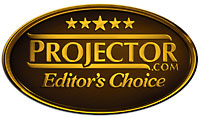
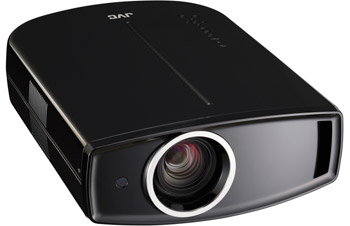
PROs |
CONs |
|
- Sketchy frame interpolation. JVC’s is better than most but you should still turn it off.
|
- Impressive out of box factory presets
|
- $5000 US Dollar street price. Well worth it if you want a serious picture. You get what you pay for.
|
- Vivid, stunning picture, with outstanding black levels and contrast detail
|
- Test pattern “freeze out”. You can’t access on-screen menus when test patterns are displayed. Kind of limits their usefulness.
|
- Easy to set up and install, with 2.1 throw ratio and significant horizontal and vertical lens offsets
|
|
|
|
|
|
- Whisper quiet in Normal lamp mode
|
|
- Nicely finished in dark shades with a subtle metallic flake
|
|
- Triple D-ILA imaging system
|
|
- Attractive, well laid out backlit remote
|
|
|
|
- Picture without compromise
|
|
- Supports next gen lockable HDMI interface
|
|
AT A GLANCE
Overview / First Impressions / Test Drive / Tweaks / Calibration / Wrap-Up

Overview
JVC DLA-HD550 1080P, 1000 Lumens, 30,000:1 Contrast, 11.2 kg, 3 x 2 cm D-ILA
Features
·
30,000:1 Native
Contrast Ratio
·
Compatibility with
the latest HDMI version 1.3 (Deep Color) specifications means that this
projector can reproduce billions of colors and subtler shades of grayscale.
·
Full 2.35:1 wide
cinematic movie enjoyment via built in vertical stretch capability.
·
High-performance 2x
zoom lens with motorized focus and zoom, enables flexible set-up.
·
120Hz Clear Motion Drive
·
New Screen Adjustment
Mode
·
Inverse Telecine
·
Sleek black cabinet
with black non-reflective front panel
·
0.7-in (16:9) Full HD
D-ILA device x 3
·
Customized on-screen gamma
control
·
Outstanding
Gray-scale reproduction
·
Wide Lens shift
function (V: 80%, H: 34%)
·
High-performance 2x
motorized zoom lens
·
Easy-to-use
self-illuminated remote control
·
User Friendly Image
adjustment menu
·
Built in test
patterns
·
New Screen Adjustment
Mode
·
Dual 1.3 HDMI 1080P
HD Inputs
·
HD Component Input
·
RS-232
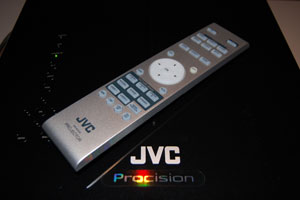
JVC’s brand new DLA-HD550 sets a very high bar for other video projectors in its class. It’s a handsome beast even when it’s off, darkly coloured, not gaudy and overdressed like the JVC Pro models. Picture quality is incredible, with a vivid picture that can show you the limitations and differences of your HD source material. I used a variety of Blu-Ray source material, from Curse of the Golden Flower, BBC’s Planet Earth, and Blade Runner, and each disc had a distinct look and feel that can only be described as seeing the palette of the film itself, and not the look of the projector. Every TV, projector, or monitor, adds artifacts and mistakes in the colour performance and decoding, simply by displaying a picture. The DLA-HD550 on the other hand, acts more like a window to the source, perfectly displaying the picture as originally intended.
First Impressions
It’s smaller than anticipated, although it’s still pretty large. Something with a reputation this large should be bigger. The finish is fantastic - subtle metallic flake, not too flashy, beautifully executed. The inputs are arranged on the side in a long-ish layout, not clustered in the back. Properly installed, the cabling should be next to invisible, which is more difficult with this sort of layout. Also, no lens cap – the lens is covered by a sliding door when not in use. Strangest of all is that there are no manual lens controls. Instead the lens is fully motorized. All adjustments are done, easily, by pushing the “Lens” button on the remote.
Another nice feature are the HDMI ports. JVC has built in support of the new breed of HDMI ends, which features an active locking system. No more will your HDMI connector work it’s way out of an HDMI port, at least once the rest of the world begins supporting lockable HDMI. It’s great to see this on a street projector.
Our DLA-HD550 was set up on a table top about 16 feet from a 119” Draper Premiere, a tensioned electric screen with Draper’s High Def Grey material. The picture source is 1080P 24 and 60 FPS, via HDMI from a Pioneer BDP51FD.
Now on to the fun stuff.
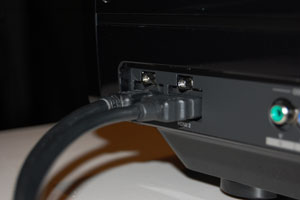
Test Drive
If you’ve bought one of these, congratulations! Now stop reading this and go open the box, turn it on and prepare to be blown away. If you’re on the fence about spending this kind of money on a projector, stay put. This might help. There are a lot of well-reviewed projectors out there that do a pretty good job, and cost about half as much. However, this is one projector where every dollar you spend shows on the screen. There’s nothing cheap, flimsy, or poorly executed about this projector. Exactly the opposite. This projector is worth every dollar. Many first timers may be put off by the price, and that’s a mistake. The DLA-HD550 is more expensive, but absolutely worth every penny.
Set up was ridiculously easy. I haven’t reviewed a D-ILA projector before and didn’t know what to expect… versatile like a 3LCD or pain in the a** like DLP? Relax, this is no DLP. The lens allows a 2:1 throw, and there are significant offset capabilities: 80% vertical and 34% horizontal adjustment, which is definitely in 3LCD territory. My JVC DLA-HD550 test unit was on a table top, about 6 inches lower than the bottom of the screen, and I was able to get the image perfectly centered on the screen, with perfect geometry, using nothing more than the remote. Epson and Sanyo should take note – say goodbye to your clunky, poorly designed mechanical adjustments, and hello to a better way of doing it.
The projector powers on quickly, with barely a whisper in Normal, low lamp mode. Take note - This is a very quiet projector, almost entirely without sound, even up close. The projector is set to the default Natural colour mode right out of the box.
You spend more time touching the remote than the projector. It had better be good. This one is. JVC has designed a remote that’s slim, attractive, and highly functional. Most of my time was spent using the circular navigation pad, and not using the shortcut keys. The menu layout was so intuitive and easy to use, I found it faster than activating the back light and searching for the button I wanted.
First up was Curse of the Golden Flower. Colours in this film are wonderfully over the top, and can easily appear oversaturated and computer generated. Not here. The DLA-HD550 showed accurate, life like skin tones, while at the same time dazzling my eyes with the extraordinary colour scheme of Curse. The actors appeared like natural, real people moving through a bright polychromatic world. One word? Wow.
Next up was Planet Earth. There’s a shot early in “From Pole to Pole” where the camera is mounted on a plane flying between two mountain peaks. I use this shot a lot – there’s significant judder on every other unit I’ve tested as the plane moves between the peaks. The DLA-HD550 was dead on smooth, right out of the box. This was the ClearMotion frame interpolation at its best. Head’s up? ClearMotion gets worse, but more on that later.
Time for Blade Runner.
It’s an iconic moment in film… a skimmer floats in through the city haze at night, while flame vents into the sky. The darkened city stretches to the horizon, the Tyrell pyramids loom impossibly huge. It’s a challenging moment for any display. The tendency is to crush the shadow detail to black, and bloom around the flames. The eye, when it appears, looks like an eye. With the JVC DLA-HD550, the eye looks moist. The flames appear spectral. I saw shadow subtleties on the screen I’ve never seen before, and I’ve seen this film on a lot of different display types. This is how this film was meant to be watched.
Now it needs to be better. No projector is as good as it can be right out of the box. It’s time to explore.
The menu layout is attractive and easy to navigate using the remote control. It’s an easy and powerful interface that grows with your comfort level. I would have preferred to have the ClearMotion control in the main menu. Instead it’s in the Advanced section off the main menu. It took an extra three seconds to turn off, and it’s three seconds of my life I’ll never get back. ClearMotion was defaulted ON with our pre-release model, but defaulted OFF with our actual demo.
There was a lot of back and forth between discs. I wanted to make sure I was building on what the projector was doing, and not sabotaging something very special. Here are my tweaks:
Picture Mode: Normal
Contrast: 18
Brightness: -6
Colour: 6
Colour Temp: 6500
Gamma: 2.5
Lens Aperture: 3
ClearMotion: OFF!!!!
Lamp: High
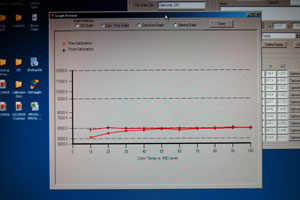
These numbers result in a better picture with wider contrast over the factory setting. Colour saturation is also enhanced, although not to the point where chroma looks too rich or fake. This is a great video projector. Even out of the box the picture is incredibly clear and lifelike. A few tweaks to taste only make a good thing better.
Next step?
Calibration
Preamble
First, ClearMotion needs to be turned off if you haven’t already. Everybody is including frame interpolation these days and it sticks out like sore thumb on a home theater piece because there is absolutely nothing theater like about it. It introduces huge artifacts into the picture. It might be good for slow moving material, like chess games and spelling bees. Anything faster than that and the circuitry chokes and blocks up. I’ll give JVC this though; their interpolation is noticeably better than Epson’s, which is as it should be given the price difference. Still, do yourself a favour and turn it off.
JVC thoughtfully included several useful test patterns, which you can access directly via the remote. There are several, and they look really impressive. The drawback is that you can’t access the menus to make picture adjustments while the patterns are displayed. This means you’ll have to make adjustments, then access the test pattern to see what changes you’ve made, then remove the pattern and bring up the menu for further adjustment. Repeat until you’re satisfied. Including the test patterns this way limits their usefulness for casual users. Not a big deal, but it’s an odd way to handle test patterns. As a result, I didn’t use the test patterns to perform the calibration, and used our digital signal generator instead.
Performance
Colour tracking tells you a lot about your video projector. It’s a look into some very high level hardware and software interactions. You can peer into the brain of your projector and see how it works. The basic idea is to put through various signals of different brightness, and test white balance for each level of brightness. In a perfect world you have a white balance of exactly 6500 Kelvin for each luminance level.
Some projectors are crazy. They’ll spike wildly into blue (say 7200 Kelvin) at one level and into red (4500 Kelvin) the next. With current calibration methods it can be difficulty calibrating these spikes out. You are instead calibrating the best average white balance for bright and dark pictures, meaning that a crazy projector can never be perfect, even after calibration.
If you’re interested, power on your DLA-HD550 and bring up the MENU. Go to White Balance, change it to Custom 1, and you’ll see the Gains and Offsets for tweaking white balance. You’ll see a wide range of adjustments, 3 for each primary colour.
So how does the DLA-HD550 stack up? This JVC is far from crazy. It has the straightest out of box white balance tracking of virtually any projector I’ve calibrated. So flat in fact that any white balance calibration might be a moot point, unless you’re super picky. Flat is better; it means that each brightness value is as close as possible to 6500 Kelvin white balance. Calibration simply confirms the decisions JVC made when designing this unit. The DLA-HD550’s pre-calibrated white balance was better than most post-calibration tests on other projectors. A few very moderate gain/offset adjustments later, the projector was off my no more than 80 Kelvin away from a perfect D65 across 95% of its brightness range.
In comparison, with the Epson 6500UB, it’s impossible to fully adjust both Blue gains and offsets. The controls simply don’t provide enough range of adjustment. There is a permanent blue push built into the white balance. Comparing the Epson to this JVC isn’t really a fair comparison.
The DLA-HD550 is not perfect, but it’s very, very close. It required only the smallest gain and offset adjustments to be fully calibrated.
Post calibration light output was extraordinary, particularly for a 1000 ANSI Lumen rated projector. The DLA-HD550 measured out 739 actual lumens, compared to 574 actual lumens with the much brighter 8500UB. The DLA-HD550 is a much brighter projector than you’d think based on the advertised numbers.
Wrap-Up
Bottom line is that you likely won’t need to calibrate this projector, provided your room is reasonably neutral coloured. It’s that good. It’s not fair to pick on JVC for ClearMotion. It’s actually a respectable execution of frame interpolation. It’s that it’s still frame interpolation with all the liabilities that go along with it. It’s an exceptional performer, with the body of a dancer and the brain of a home theater nerd. If you’re taking the plunge and you’ve decided on a home theatre, do yourself a favor. Buy it. It’s not something you’ll need or want to replace any time soon.
|






